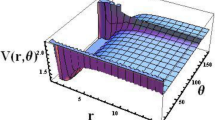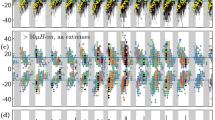Abstract
IN an article1 in Nature in 1958, it was explained how the rate of rotation of the orbital plane of an Earth satellite (the rate of regression of the nodes) could be used to evaluate the even harmonics in the Earth's gravitational potential U. At an exterior point distant r from the Earth's centre and having co-latitude θ, U may be expressed in terms of Legendre polynomials P
n as :  where G is the gravitational constant, M the mass of the Earth, R its equatorial radius, and the J
n are constants to be determined. J
1 is zero if the equator is chosen to pass through the Earth's centre of mass. The motion of a satellite in the gravitational field specified by equation (1) has been investigated theoretically2–4, and the rate of rotation of the orbital plane, Ω̇, may in principle be expressed in the form :
where G is the gravitational constant, M the mass of the Earth, R its equatorial radius, and the J
n are constants to be determined. J
1 is zero if the equator is chosen to pass through the Earth's centre of mass. The motion of a satellite in the gravitational field specified by equation (1) has been investigated theoretically2–4, and the rate of rotation of the orbital plane, Ω̇, may in principle be expressed in the form :  where the F
n and F
mn are functions of the orbital elements. Since J
2 is of order 10−3, the J
n are of order 10−6 when n > 2, and the F
n are of the same order as the F
mn, only the J
2
2 term in the second series in equation (2) need be considered, and even in that term an approximate value of J
2 is adequate. Thus each observed value of Ω̇ provides one linear relation between the J
n, and observed values from k satellites provide k simultaneous equations between the J
n. These equations are not ill-conditioned if the k orbits differ widely enough. It happens that the odd-numbered J
n have little effect on Ω̇, and the available values5 for J
3 and J
5, namely :
where the F
n and F
mn are functions of the orbital elements. Since J
2 is of order 10−3, the J
n are of order 10−6 when n > 2, and the F
n are of the same order as the F
mn, only the J
2
2 term in the second series in equation (2) need be considered, and even in that term an approximate value of J
2 is adequate. Thus each observed value of Ω̇ provides one linear relation between the J
n, and observed values from k satellites provide k simultaneous equations between the J
n. These equations are not ill-conditioned if the k orbits differ widely enough. It happens that the odd-numbered J
n have little effect on Ω̇, and the available values5 for J
3 and J
5, namely :  can be substituted into equation (2) without introducing significant error. Thus k satellites with widely different orbits—and, in particular, with widely differing orbital inclinations—will yield values of J
2, J
4, … J
2k if we are prepared to assume that the contributions of J
7, J
9 … and of J
2k + 2, J
2k + 4, … are negligible.
can be substituted into equation (2) without introducing significant error. Thus k satellites with widely different orbits—and, in particular, with widely differing orbital inclinations—will yield values of J
2, J
4, … J
2k if we are prepared to assume that the contributions of J
7, J
9 … and of J
2k + 2, J
2k + 4, … are negligible.
This is a preview of subscription content, access via your institution
Access options
Subscribe to this journal
Receive 51 print issues and online access
$199.00 per year
only $3.90 per issue
Buy this article
- Purchase on Springer Link
- Instant access to full article PDF
Prices may be subject to local taxes which are calculated during checkout
Similar content being viewed by others
References
Merson, R. H., and King-Hele, D. G., Nature, 182, 640 (1958).
King-Hele, D. G., Proc. Roy. Soc., A, 247, 49 (1958).
Groves, G. V., Proc. Roy. Soc., A, 254, 48 (1960).
Merson, R. H., Ministry of Aviation Report (to be published).
O'Keefe, J. A., Eckels, A., and Squires, R. K., Astro. J., 64, 245 (1959).
King-Hele, D. G., paper presented at tenth Int. Astronautical Cong., London (1959).
Jeffreys, H., “The Earth”, third ed. (Camb. Univ. Press, 1952).
Author information
Authors and Affiliations
Rights and permissions
About this article
Cite this article
KING-HELE, D. Evaluation of the Second, Fourth and Sixth Harmonics in the Earth's Gravitational Potential. Nature 187, 490–491 (1960). https://doi.org/10.1038/187490b0
Issue Date:
DOI: https://doi.org/10.1038/187490b0
Comments
By submitting a comment you agree to abide by our Terms and Community Guidelines. If you find something abusive or that does not comply with our terms or guidelines please flag it as inappropriate.



